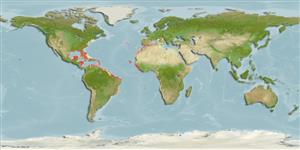Issue
Regarded as nomina dubia by Sakai & Nakabo, 2014 (Ref. 95333). See explanation of the correct name choice to Kyphosus sectatrix (Linnaeus, 1758) versus saltatrix in Eschmeyer (CofF ver. Oct. 2012: Ref. 92135).
Environment: milieu / climate zone / distribuzione batimetrica / distribution range
Ecologia
marino associati a barriera corallina; distribuzione batimetrica 1 - 30 m (Ref. 9626), usually 1 - 10 m (Ref. 40849). Subtropical; 46°N - 29°S, 98°W - 16°E
Circumglobal.
Size / Peso / Age
Maturità: Lm ? range ? - ? cm
Max length : 76.0 cm TL maschio/sesso non determinato; (Ref. 5288); common length : 50.0 cm TL maschio/sesso non determinato; (Ref. 3397); peso massimo pubblicato: 6.0 kg (Ref. 40637)
Spine dorsali (totale) : 11; Raggi dorsali molli (totale) : 11 - 12; Spine anali: 3; Raggi anali molli: 11. Gray overall, with faint yellow lines on side and yellow line from corner of mouth to preopercle (Ref. 26938). Upper part pf opercular membrane blackish. The young may display pale spots nearly as large as eye on the head, body and fins (Ref. 13442). Each jaw with a regular row of close-set, strong, incisor-like, round-tipped teeth of a peculiar hockey stick-shape, their bases set horizontally, resembling a radially striated bony plate inside mouth (Ref 52729).
Body shape (shape guide): fusiform / normal.
Inhabits shallow waters, over turtle grass, sand or rocky bottom and around coral reefs (Ref. 3725). Young commonly found among floating Sargassum seaweeds (Ref. 3725). Feeds on plants, mainly on benthic algae, as well as on small crabs and mollusks (Ref. 6547, 44187). Also feeds on spinner dolphins’ feces and vomits at Fernando de Noronha Archipelago, southeast Atlantic. The offal feeding may be regarded as a simple behavioral shift from plankton feeding to drifting offal picking (Ref. 48727). Marketed fresh (Ref. 3725).
Life cycle and mating behavior
Maturità | Riproduzione | Deposizione | Uova | Fecundity | Larve
Knudsen, S.W. and K.D. Clements, 2013. Revision of the fish family Kyphosidae (Teleostei: Perciformes). Zootaxa 3751(1):001-101. (Ref. 95491)
IUCN Red List Status (Ref. 130435: Version 2025-1)
Threat to humans
Harmless
Human uses
Pesca: scarso interesse commerciale; Pesce da pesca sportiva: si; Acquario: Acquari pubblici
Strumenti
Special reports
Download XML
Fonti Internet
Estimates based on models
Preferred temperature (Fonte Biblio.
123201): 20.1 - 28, mean 27 °C (based on 1240 cells).
Phylogenetic diversity index (Fonte Biblio.
82804): PD
50 = 0.5000 [Uniqueness, from 0.5 = low to 2.0 = high].
Bayesian length-weight: a=0.01445 (0.00616 - 0.03392), b=3.01 (2.81 - 3.21), in cm total length, based on LWR estimates for this (Sub)family-body shape (Ref.
93245).
Trophic level (Fonte Biblio.
69278): 2.0 ±0.0 se; based on diet studies.
Resilienza (Fonte Biblio.
120179): Basso, tempo minimo di raddoppiamento della popolazione 4.5 - 14 anni (Preliminary K or Fecundity.).
Fishing Vulnerability (Ref.
59153): Moderate to high vulnerability (50 of 100).
🛈
Climate Vulnerability (Ref.
125649): High to very high vulnerability (70 of 100).
🛈
Nutrients (Ref.
124155): Calcium = 24.6 [9.4, 39.5] mg/100g; Iron = 0.545 [0.304, 0.913] mg/100g; Protein = 19.3 [18.1, 20.5] %; Omega3 = 0.146 [0.081, 0.262] g/100g; Selenium = 17.6 [8.3, 38.5] μg/100g; VitaminA = 29.2 [7.6, 106.5] μg/100g; Zinc = 0.968 [0.639, 1.461] mg/100g (wet weight);
